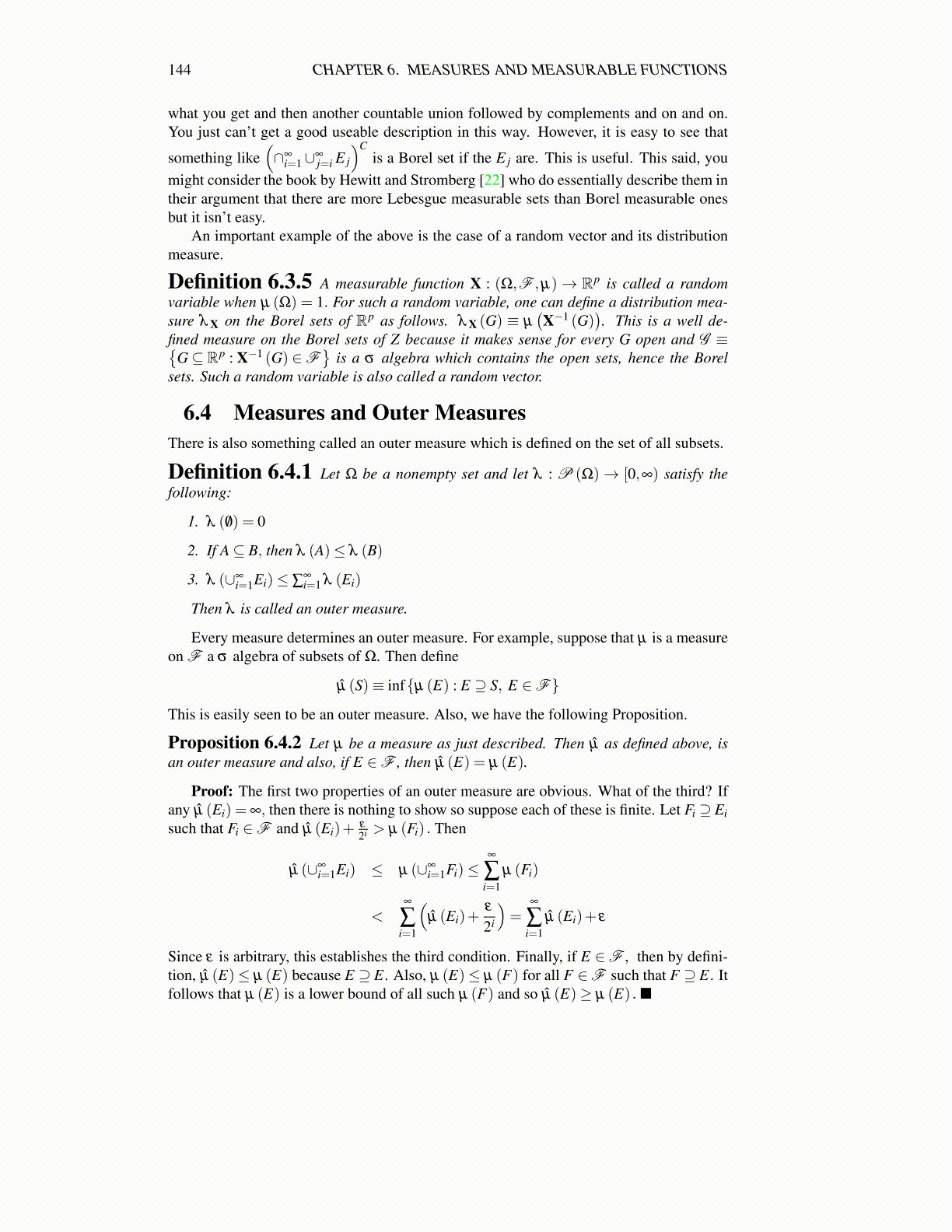
144 CHAPTER 6. MEASURES AND MEASURABLE FUNCTIONS
what you get and then another countable union followed by complements and on and on.You just can’t get a good useable description in this way. However, it is easy to see that
something like(∩∞
i=1∪∞j=i E j
)Cis a Borel set if the E j are. This is useful. This said, you
might consider the book by Hewitt and Stromberg [22] who do essentially describe them intheir argument that there are more Lebesgue measurable sets than Borel measurable onesbut it isn’t easy.
An important example of the above is the case of a random vector and its distributionmeasure.
Definition 6.3.5 A measurable function X : (Ω,F ,µ)→ Rp is called a randomvariable when µ (Ω) = 1. For such a random variable, one can define a distribution mea-sure λ X on the Borel sets of Rp as follows. λ X (G) ≡ µ
(X−1 (G)
). This is a well de-
fined measure on the Borel sets of Z because it makes sense for every G open and G ≡{G⊆ Rp : X−1 (G) ∈F
}is a σ algebra which contains the open sets, hence the Borel
sets. Such a random variable is also called a random vector.
6.4 Measures and Outer MeasuresThere is also something called an outer measure which is defined on the set of all subsets.
Definition 6.4.1 Let Ω be a nonempty set and let λ : P (Ω)→ [0,∞) satisfy thefollowing:
1. λ ( /0) = 0
2. If A⊆ B, then λ (A)≤ λ (B)
3. λ (∪∞i=1Ei)≤ ∑
∞i=1 λ (Ei)
Then λ is called an outer measure.
Every measure determines an outer measure. For example, suppose that µ is a measureon F a σ algebra of subsets of Ω. Then define
µ̂ (S)≡ inf{µ (E) : E ⊇ S, E ∈F}
This is easily seen to be an outer measure. Also, we have the following Proposition.
Proposition 6.4.2 Let µ be a measure as just described. Then µ̂ as defined above, isan outer measure and also, if E ∈F , then µ̂ (E) = µ (E).
Proof: The first two properties of an outer measure are obvious. What of the third? Ifany µ̂ (Ei) = ∞, then there is nothing to show so suppose each of these is finite. Let Fi ⊇ Eisuch that Fi ∈F and µ̂ (Ei)+
ε
2i > µ (Fi) . Then
µ̂ (∪∞i=1Ei) ≤ µ (∪∞
i=1Fi)≤∞
∑i=1
µ (Fi)
<∞
∑i=1
(µ̂ (Ei)+
ε
2i
)=
∞
∑i=1
µ̂ (Ei)+ ε
Since ε is arbitrary, this establishes the third condition. Finally, if E ∈F , then by defini-tion, µ̂ (E)≤ µ (E) because E ⊇ E. Also, µ (E)≤ µ (F) for all F ∈F such that F ⊇ E. Itfollows that µ (E) is a lower bound of all such µ (F) and so µ̂ (E)≥ µ (E) .■